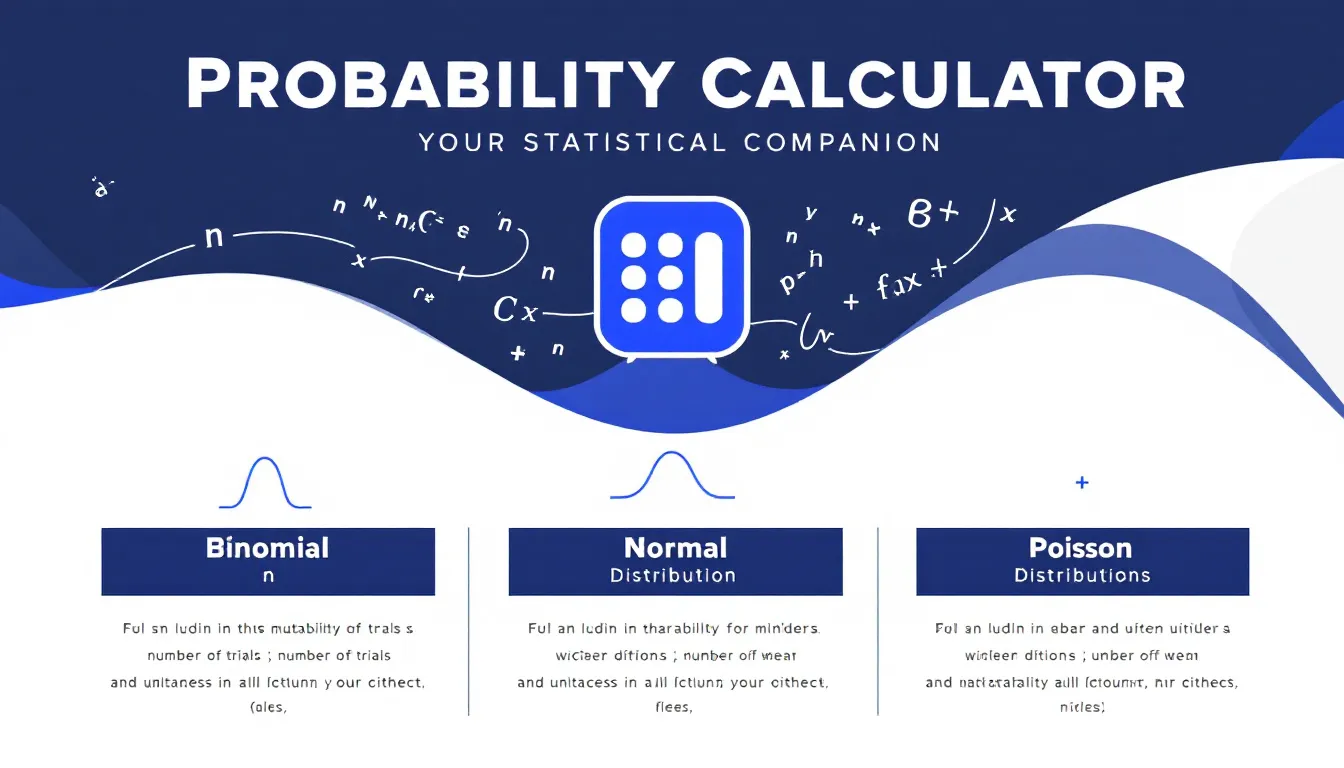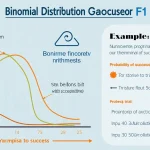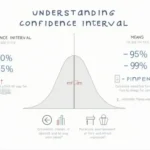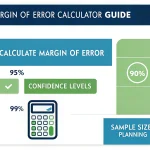Probability Calculator
How to use the tool
- Select a distribution. Pick Binomial, Normal or Poisson from the menu.
- Fill every field. The calculator checks ranges automatically—no negative σ or λ.
- Hit “Calculate”. Your probability appears below the form together with an interactive chart.
- Download or screenshot the chart for reports or presentations.
Binomial fields
- Number of trials (n) – whole number ≥ 1. Examples: 15 coin flips, 60 manufactured parts.
- Probability of success (p) – 0 ≤ p ≤ 1. Examples: 0.42 defect rate, 0.95 pass probability.
- Number of successes (k) – 0 ≤ k ≤ n. Examples: exactly 6 heads, 54 good parts.
Normal fields
- Mean (μ) – any real value. Examples: 72 kg weight, 12 V voltage.
- Standard deviation (σ) – positive. Examples: 6 kg, 0.3 V.
- Value (X) – point for cumulative probability. Examples: 80 kg, 11.7 V.
Poisson fields
- Average rate (λ) – positive. Examples: 3.8 emails/min, 12 hits/hour.
- Occurrences (k) – whole number ≥ 0. Examples: 2 emails, 15 hits.
Formulas
- Binomial: $$P(X=k)= rac{n!}{k!(n-k)!}\,p^{k}(1-p)^{n-k}$$
- Normal (cumulative): $$P(X\le x)=\Phi\!\left( rac{x-\mu}{\sigma}\right)$$ where Φ is the standard-normal CDF.
- Poisson: $$P(X=k)= rac{\lambda^{k}e^{-\lambda}}{k!}$$
Example calculations
- Binomial: n = 12, p = 0.3, k = 4 → P = 0.231 (Stat Trek, 2023).
- Normal: μ = 50, σ = 5, X = 60 → P(X ≤ 60) = 0.977 2 (NIST Z-table, 2013).
- Poisson: λ = 4.5, k = 2 → P ≈ 0.113 (Walpole & Myers, 2012).
Quick-Facts
- Binomial variance equals n p (1 − p) (NIST Handbook 151, 2014).
- Φ(1.96) = 0.975; used for 95 % confidence limits (ISO 3534-1, 2006).
- Poisson mean equals its variance λ (Stat Trek, 2023).
- σ must be > 0; zero leads to undefined z-scores (Montgomery, 2020).
FAQ
What is the difference between cumulative and exact probability?
Cumulative sums probabilities up to a point (≤ k or ≤ X); exact gives only P(X = k). Exact suits “exactly five defects,” cumulative suits “at most five defects” (Moore & McCabe, 2021).
Can I input decimal successes in the Binomial field?
No. k must be an integer because successes are countable events (NIST Handbook 151, 2014).
Why does the Normal option return a value near 0.5 when X equals μ?
The CDF at the mean of a symmetric normal distribution is 0.5 by definition (ISO 3534-1, 2006).
How do I interpret a Poisson probability of 0.113?
You expect that outcome roughly 11 % of intervals; “events are rare yet possible,” notes Walpole & Myers (2012).
What range of λ is practical?
Models work well for λ ≤ 30; above this Poisson approximates Normal with μ = λ and σ ≈ √λ (Ross, 2022).
Do factorials limit n in the Binomial formula?
Large n cause overflow in direct factorials; the tool uses logarithms beyond n ≈ 170 (Press et al., 2007).
Is the calculator suitable for confidence intervals?
Use its probabilities to build intervals—e.g., two-tailed α = 0.05 uses z = ±1.96 (ISO 3534-1, 2006).
Why must σ and λ be positive?
Negative dispersion contradicts probability theory; “variance cannot be negative” (Montgomery, 2020).
Is this tool helpful?
Important Disclaimer
The calculations, results, and content provided by our tools are not guaranteed to be accurate, complete, or reliable. Users are responsible for verifying and interpreting the results. Our content and tools may contain errors, biases, or inconsistencies. Do not enter personal data, sensitive information, or personally identifiable information in our web forms or tools. Such data entry violates our terms of service and may result in unauthorized disclosure to third parties. We reserve the right to save inputs and outputs from our tools for the purposes of error debugging, bias identification, and performance improvement. External companies providing AI models used in our tools may also save and process data in accordance with their own policies. By using our tools, you consent to this data collection and processing. We reserve the right to limit the usage of our tools based on current usability factors.







